Rumstation, der markerer 20 år for mennesker, der lever i kredsløb
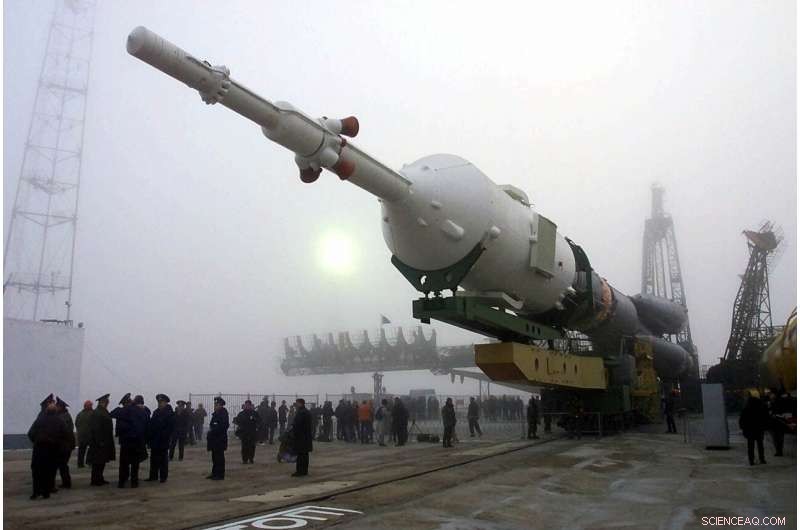
I denne 29. okt. 2000, fil foto, Soyuz-boosteren transporteres til affyringsrampen på Baikonur Cosmodrome i Kazakstan. To dage senere, Den amerikanske astronaut Bill Shepherd, og de russiske kosmonauter Sergei Krikalyov og Yuri Gidzenko eksploderede for at blive de første beboere på den internationale rumstation. (AP Photo/Mikhail Metzel, Fil)
Den Internationale Rumstation var en trang, fugtig, små tre værelser, da den første besætning flyttede ind. Tyve år og 241 besøgende senere, komplekset har et udsigtstårn, tre toiletter, seks sovekabiner og 12 værelser, alt efter hvordan du tæller.
Mandag markerer to årtier med en lind strøm af mennesker, der bor der.
Astronauter fra 19 lande har svævet gennem rumstationens luger, herunder mange tilbagevendende besøgende, der ankom med shuttle til kortvarigt byggearbejde, og flere turister, der betalte deres egen vej.
Det første mandskab – amerikaneren Bill Shepherd og russerne Sergei Krikalev og Yuri Gidzenko – sprængte fra Kasakhstan den 31. oktober, 2000. To dage senere, de åbnede rumstationens døre, slår hænderne sammen.
Fårehyrde, en tidligere Navy SEAL, der tjente som stationschef, sammenlignede det med at bo på et skib på havet. De tre brugte det meste af deres tid på at lokke udstyr til arbejde; balky systemer gjorde stedet for varmt. Forholdene var primitive, sammenlignet med nu.
Installationer og reparationer tog timer på den nye rumstation, kontra minutter på jorden, Krikalev erindrede.
"Hver dag så ud til at have sit eget sæt af udfordringer, " sagde Shepherd under en nylig NASA-paneldiskussion med sine besætningsmedlemmer.
Rumstationen har siden forvandlet sig til et kompleks, der er næsten lige så langt som en fodboldbane, med 13 kilometer elektriske ledninger, en hektar solpaneler og tre højteknologiske laboratorier.
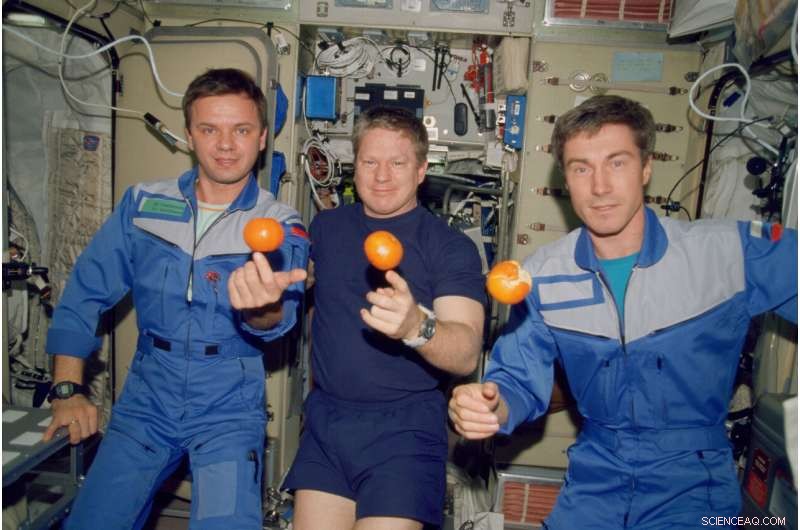
På dette billede leveret af NASA, Ekspedition 1-besætningsmedlemmerne poserer med friske appelsiner ombord på Zvezda Service Module på den Jord-kredsende Internationale Rumstation den 4. december, 2000. Afbildet, fra venstre, er kosmonaut Yuri P. Gidzenko, Sojuz-kommandant; astronaut Bill Shepherd, missionschef; og kosmonaut Sergei K. Krikalev, flyveingeniør. (NASA via AP)
"Det er 500 tons ting, der zoomer rundt i rummet, de fleste af dem rørte aldrig hinanden, før de kom derop og boltrede sig, " fortalte Shepherd til The Associated Press. "Og det hele har kørt i 20 år med næsten ingen store problemer."
"Det er et reelt bevis på, hvad der kan gøres i den slags programmer, " han sagde.
Fårehyrde, 71, er for længst pensioneret fra NASA og bor i Virginia Beach, Virginia. Krikalev, 62, og Gidzenko, 58, er steget i de russiske rumfartsrækker. Begge var involveret i lanceringen af den 64. besætning midt i oktober.
Det første de tre gjorde engang, da de ankom til den mørklagte rumstation den 2. november, 2000, tændte lyset, som Krikalev huskede som "meget mindeværdig." Så opvarmede de vand til varme drikke og aktiverede det enlige toilet.
"Nu kan vi leve, " Gidzenko husker, at Shepherd sagde. "Vi har lys, vi har varmt vand og vi har toilet."
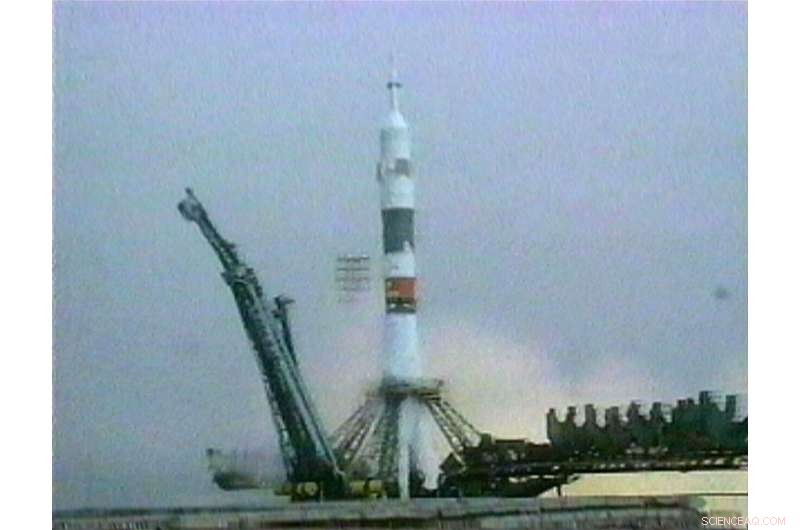
I denne 31. okt. 2000, filbillede fra video leveret af NASA, en røgsky omgiver Soyuz-raketten sekunder før afgang fra Baikonur Cosmodrome i Kazakstan, med de første beboere på den internationale rumstation. To dage senere, Den amerikanske astronaut Bill Shepherd, og russiske kosmonauter Sergei Krikalev, og Yuri Gidzenko ankom til rumstationen. (NASA via AP, Fil)
Besætningen kaldte deres nye hjem Alpha, men navnet holdt ikke fast.
Selvom det er banebrydende på vejen, de tre havde ingen tætte opkald i løbet af deres næsten fem måneder deroppe, Shepherd sagde, og indtil videre har stationen holdt sig relativt godt.
NASA's top concern nowadays is the growing threat from space junk. Dette år, the orbiting lab has had to dodge debris three times.
As for station amenities, astronauts now have near-continuous communication with flight controllers and even an internet phone for personal use. The first crew had sporadic radio contact with the ground; communication blackouts could last hours.
While the three astronauts got along fine, tension sometimes bubbled up between them and the two Mission Controls, in Houston and outside Moscow. Shepherd got so frustrated with the "conflicting marching orders" that he insisted they come up with a single plan.
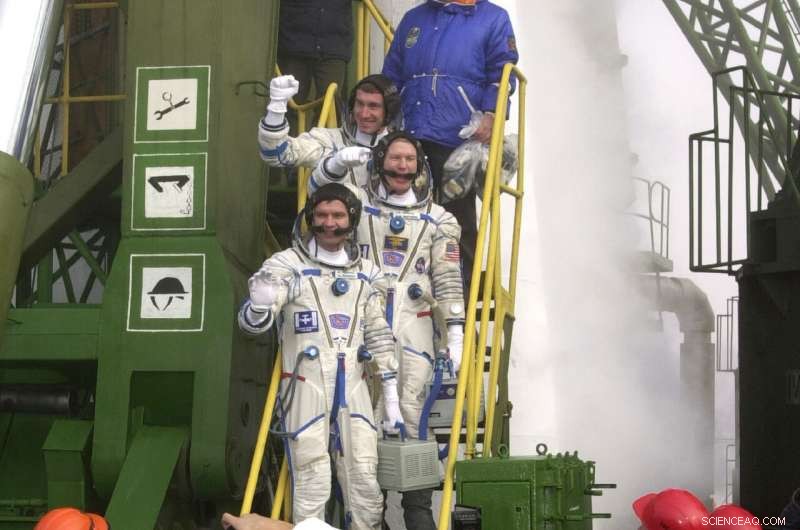
In this Oct. 31, 2000, photo provided by NASA, Expedition 1 crew members, from top, Sergei K. Krikalev, Bill Shepherd and Yuri P. Gidzenko pose for final photos prior to their launch aboard a Soyuz rocket to the International Space Station from the Baikonur Cosmodrome in Kazakhstan. To dage senere, they swung open the space station doors, clasping their hands in unity. Thus began 20 years of international cooperation and a steady stream of crew from around the world. (NASA via AP)
"I've got to say, that was my happiest day in space, " he said during the panel discussion.
With its first piece launched in 1998, the International Space Station already has logged 22 years in orbit. NASA and its partners contend it easily has several years of usefulness left 260 miles (400 kilometers) up.
The Mir station—home to Krikalev and Gidzenko in the late 1980s and 1990s—operated for 15 years before being guided to a fiery reentry over the Pacific in 2001. Russia's earlier stations and America's 1970s Skylab had much shorter life spans, as did China's much more recent orbital outposts.
Astronauts spend most of their six-month stints these days keeping the space station running and performing science experiments. A few have even spent close to a year up there on a single flight, serving as medical guinea pigs. Shepherd and his crew, derimod barely had time for a handful of experiments.
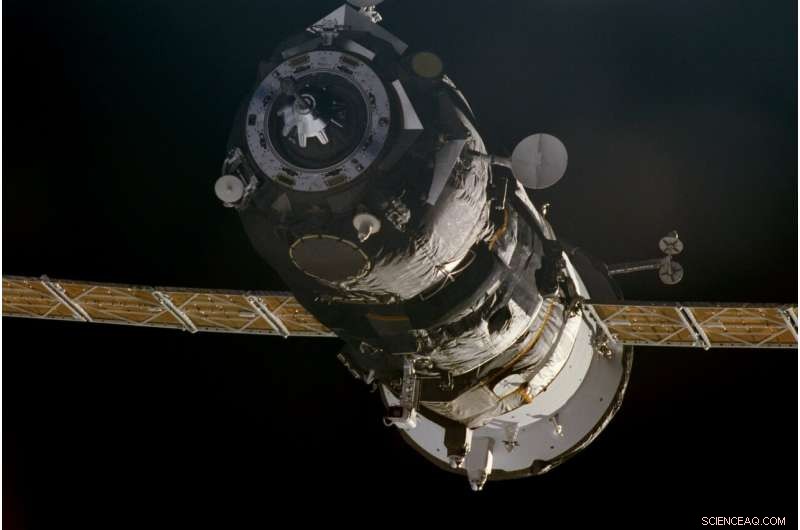
This photo provided by NASA shows a Progress supply ship that arrived on Nov. 18, 2000 to link up to the International Space Station, bringing Expedition 1 commander Bill Shepherd, pilot Yuri P. Gidzenko and flight engineer Sergei K. Krikalev two tons of food, tøj, hardware and holiday gifts from their families. (NASA via AP)
The first couple weeks were so hectic—"just working and working and working, " according to Gidzenko—that they didn't shave for days. It took awhile just to find the razors.
Even back then, the crew's favorite pastime was gazing down at Earth. It takes a mere 90 minutes for the station to circle the world, allowing astronauts to soak in a staggering 16 sunrises and 16 sunsets each day.
The current residents—one American and two Russians, just like the original crew—plan to celebrate Monday's milestone by sharing a special dinner, enjoying the views of Earth and remembering all the crews who came before them, especially the first.
But it won't be a day off:"Probably we'll be celebrating this day by hard work, " Sergei Kud-Sverchkov said Friday from orbit.
One of the best outcomes of 20 years of continuous space habitation, according to Shepherd, is astronaut diversity.
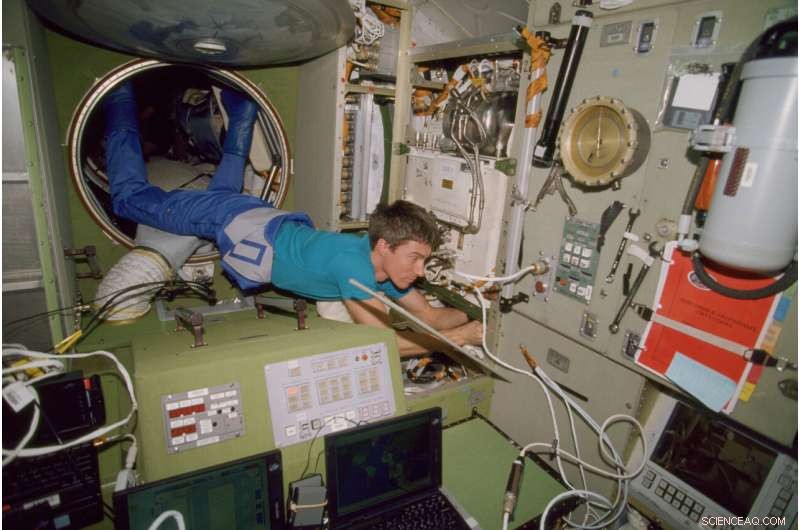
På dette billede leveret af NASA, Expedition 1 flight engineer Sergei K. Krikalev works in the Zvezda Service Module, with his feet anchored in a tunnel hatchway, aboard the International Space Station on Dec. 6, 2000. The space station was cramped and humid with just three rooms when the first crew moved in. Conditions were primitive, compared with now, and the three spent most of their time coaxing equipment to work. In the past twenty years, the space station has morphed into a complex that's almost as long as a football field, with eight miles (13 kilometers) of electrical wiring and three high-tech labs. (NASA via AP)
While men still lead the pack, more crews include women. Two U.S. women have served as space station skipper. Commanders typically are American or Russian, but have also come from Belgium, Tyskland, Italien, Canada and Japan. While African-Americans have made short visits to the space station, the first Black resident is due to arrive in mid-November on SpaceX's second astronaut flight.
Massive undertakings like human Mars trips can benefit from the past two decades of international experience and cooperation, Shepherd said.
"If you look at the space station program today, it's a blueprint on how to do it. All those questions about how this should be organized and what it's going to look like, the big questions are already behind us, " he told the AP.
Rusland, for eksempel, kept station crews coming and going after NASA's Columbia disaster in 2003 and after the shuttles retired in 2011.
-
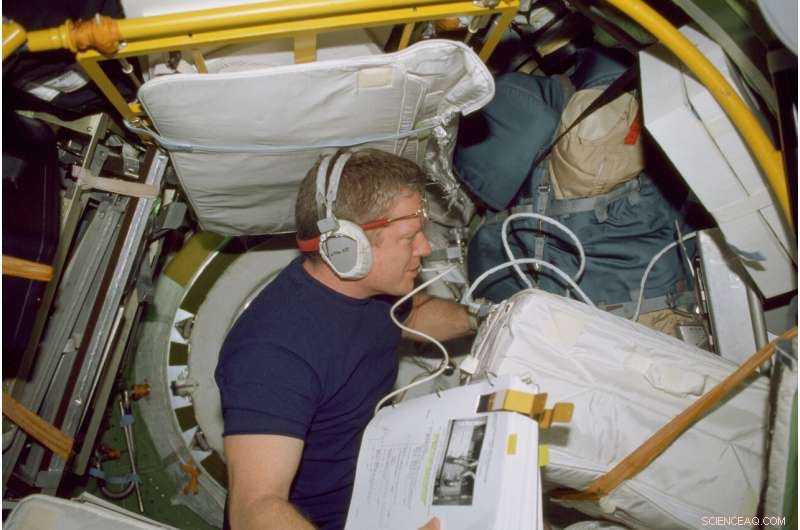
På dette billede leveret af NASA, Expedition 1 mission commander Bill Shepherd works in a docking compartment aboard the International Space Station on Dec. 5, 2000. The International Space Station was a cramped, humid, puny three rooms when the first crew moved in. Twenty years and 241 residents later, the complex has a domed lookout, three toilets, six sleeping compartments and 10 rooms, depending on how you count. (NASA via AP)
-
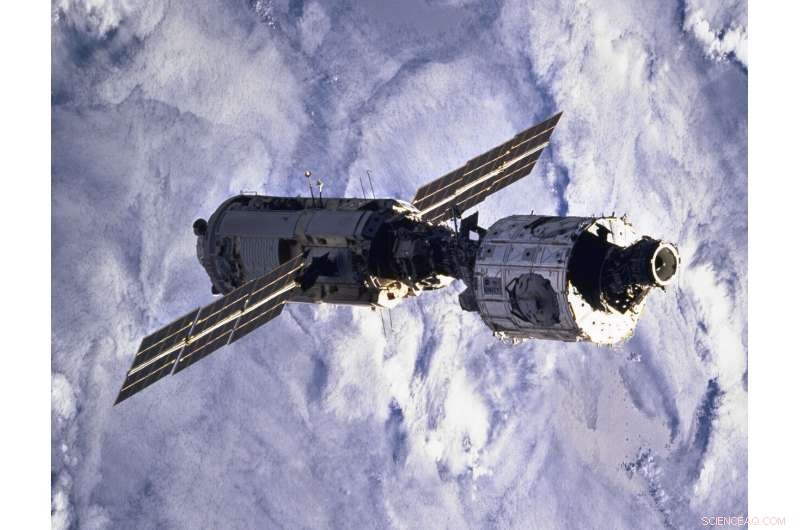
This photo provided by NASA shows the new International Space Station after the crew of the Space Shuttle Endeavour captured the Zarya Control Module, venstre, and mated it with the Unity Node, ret, inside the Shuttle's payload bay. This photo was taken after Endeavour undocked from the space station on Dec. 13, 1998, for the return to Earth. Almost two years later, the first crew—American Bill Shepherd and Russians Sergei Krikalev and Yuri Gidzenko—blasted off from Kazakhstan on Oct. 31, 2000, en route to the space station. Thus began 20 years of international cooperation and a steady stream of crew from around the world. (NASA via AP)
-
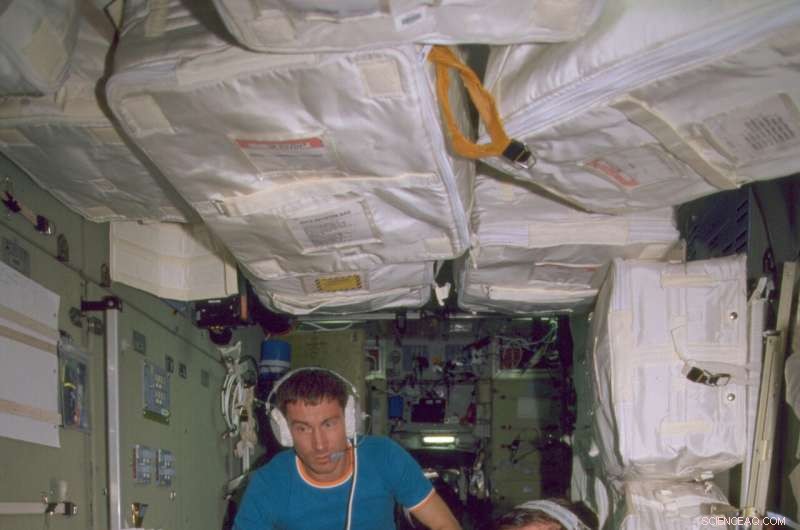
På dette billede leveret af NASA, Expedition 1 crew members Sergei Krikalev, venstre, and Yuri Gidzenko work in the Zvezda Service Module onboard the International Space Station on Nov. 8, 2000. The first crew, Russians Krikalev and Gidzenko along with American Bill Shepherd, spent most of their time coaxing equipment to work in the cramped and humid three-room space station. Twenty years and 241 residents later, the complex is almost as long as a football field, with six sleeping compartments, three toilets, a domed lookout and three high-tech labs. (NASA via AP)
-
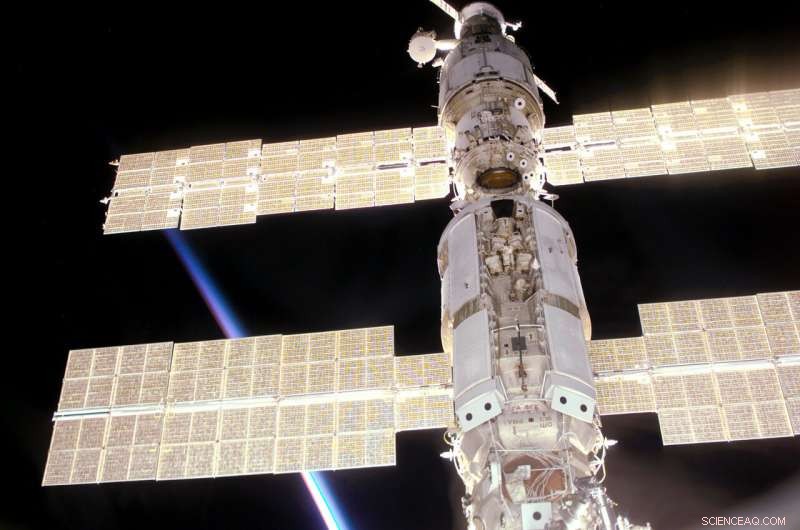
This photo provided by NASA shows the International Space Station as seen from Space Shuttle Atlantis during mission STS-106, which delivered supplies and performed maintenance in September 2000. The first crew of the space station—American Bill Shepherd and Russians Sergei Krikalev and Yuri Gidzenko—arrived less than two months later. Thus began 20 years of international cooperation and a steady stream of crew from around the world. (NASA via AP)
-
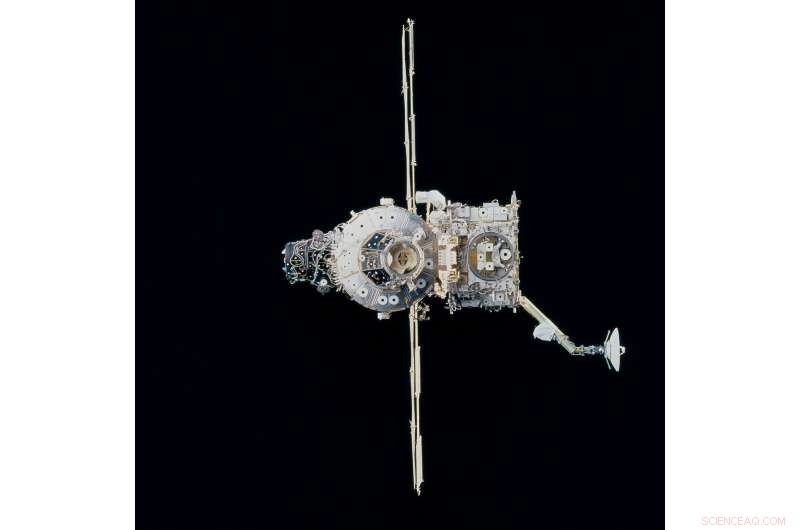
This Oct. 20, 2000 photo made available by NASA shows the International Space Station after separation of the Space Shuttle Discovery. Backdropped against the blackness of space, the Z1 Truss structure and its antenna, as well as the new pressurized mating adapter (PMA-3), are visible in the foreground. (NASA via AP)
-
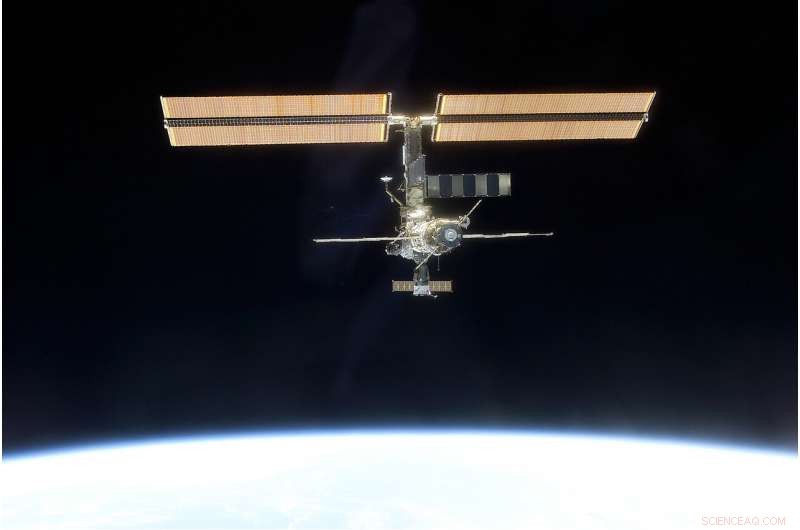
På dette billede leveret af NASA, the International Space Station, backdropped against black space above Earth's horizon, is seen from the Space Shuttle Discovery on March 19, 2001, after a new crew comprised of cosmonaut Yury Usachev and astronauts James Voss and Susan Helms began several months aboard the station. In the early days of the station, it was a cramped and humid, with just three rooms. It's much larger now, with six sleeping compartments, three toilets, a domed lookout and three high-tech labs. (NASA via AP)
-
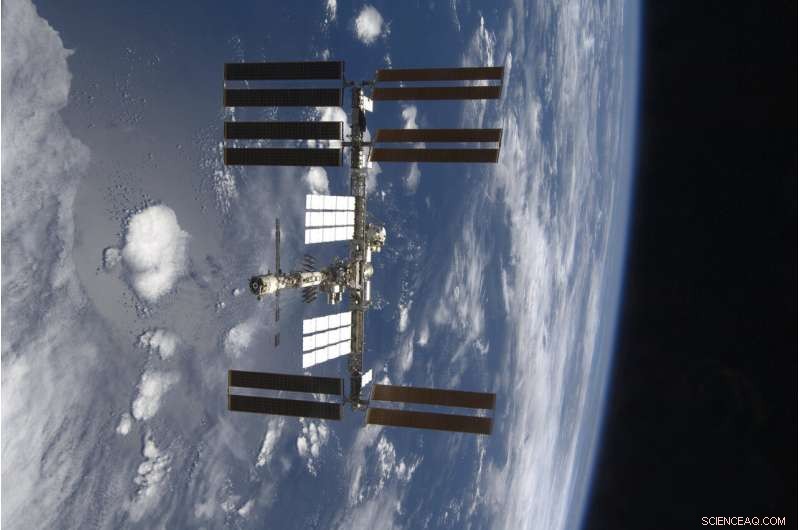
This photo provided by NASA shows the International Space Station as seen from Space Shuttle Endeavour as the two spacecraft begin their relative separation on Nov. 28, 2008. Twenty years after the first crew arrived at the space station, the spacecraft has hosted 241 residents and grown from three cramped and humid rooms to a complex almost as long as a football field, with six sleeping compartments, three toilets, a domed lookout and three high-tech labs. (NASA via AP)
-
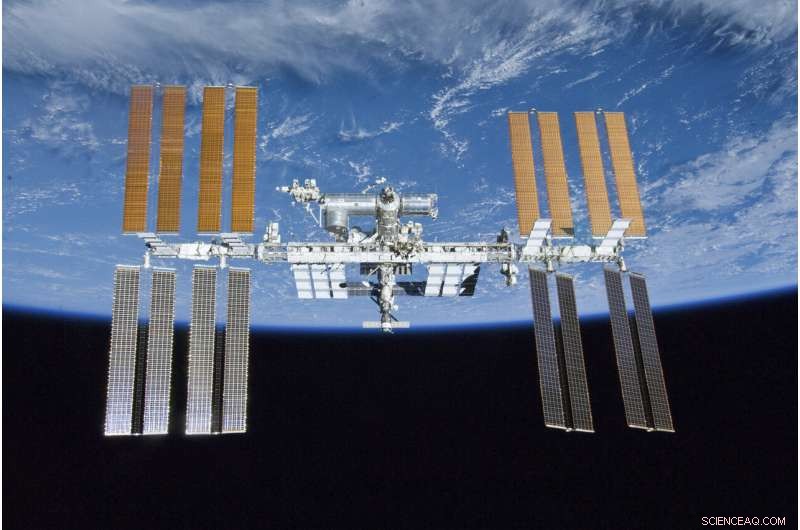
This photo provided by NASA shows the International Space Station as seen from the Space Shuttle Atlantis after the station and shuttle began their post-undocking relative separation on May 23, 2010. Twenty years after the first crew arrived, the space station has hosted 241 residents and grown from three cramped and humid rooms to a complex almost as long as a football field, with six sleeping compartments, three toilets, a domed lookout and three high-tech labs. (NASA via AP)
-
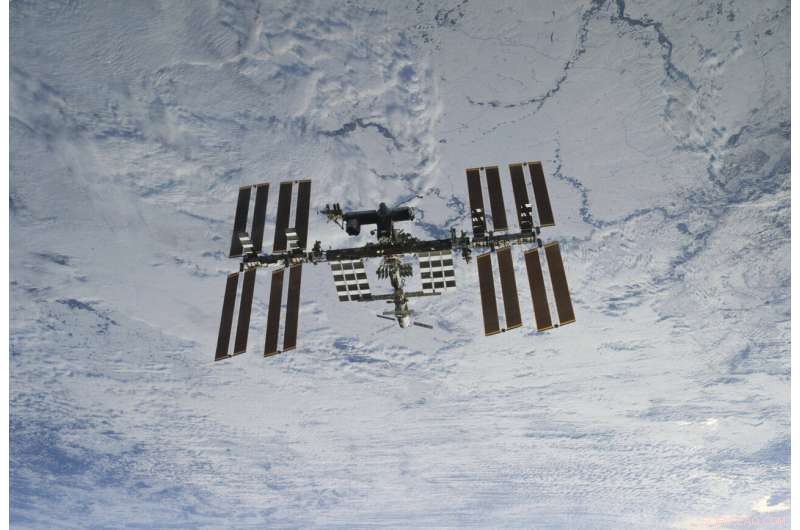
På dette billede leveret af NASA, backdropped against clouds over Earth, the International Space Station is seen from Space Shuttle Discovery as the two orbital spacecraft accomplish their relative separation on March 7, 2011. From the first crew to the most recent, the No. 1 pastime aboard the station is gazing down at Earth. It takes just 90 minutes to circle the world, allowing crews to soak in a staggering 16 sunrises and 16 sunsets every day. (NASA via AP)
-
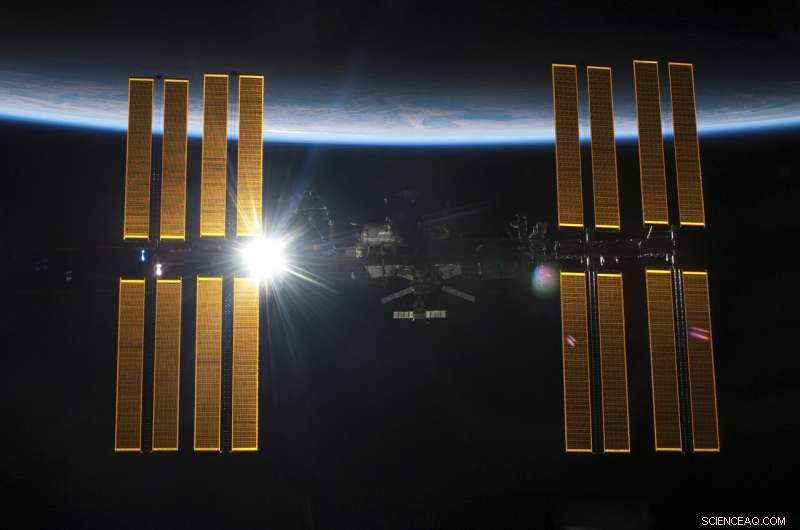
In this image provided by NASA, the International Space Station is seen from the Space Shuttle Endeavour on May 29, 2011, after the station and shuttle began their post-undocking relative separation. It takes just 90 minutes for the space station to circle the world, allowing crews to see 16 sunrises and 16 sunsets every day. (NASA via AP)
-
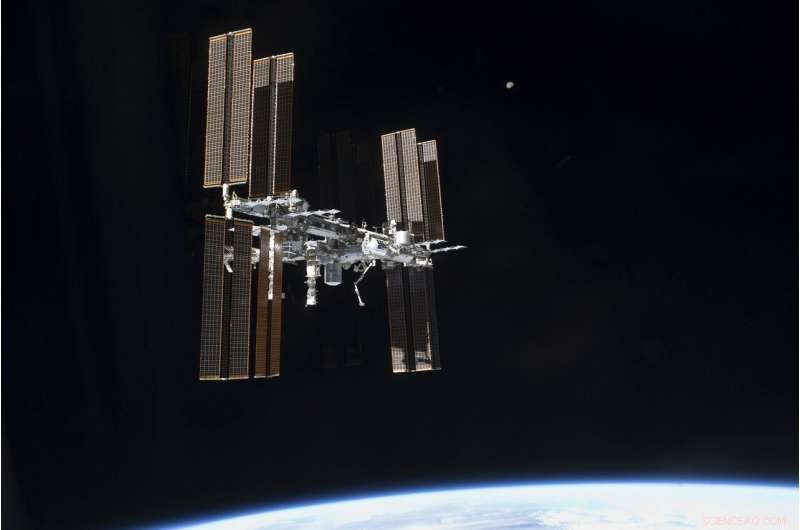
På dette billede leveret af NASA, the International Space Station is seen from the Space Shuttle Atlantis as the two spacecraft perform their relative separation on July 19, 2011. Above and to the right of the space station is the moon far in the distance. (NASA via AP)
-
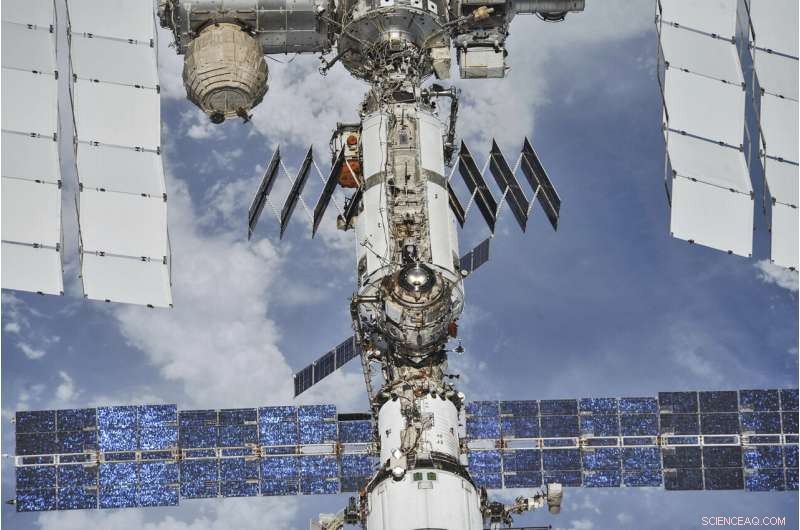
In this photo provided by NASA/Roscosmos, the International Space Station floats above the Earth as seen from a Soyuz spacecraft after undocking on Oct. 4, 2018. NASA astronauts Andrew Feustel and Ricky Arnold and Roscosmos cosmonaut Oleg Artemyev executed a fly around of the orbiting laboratory to take pictures of the station before returning home after spending 197 days in space. Twenty years after the first crew arrived, the space station has hosted 241 residents. (NASA/Roscosmos via AP)
-
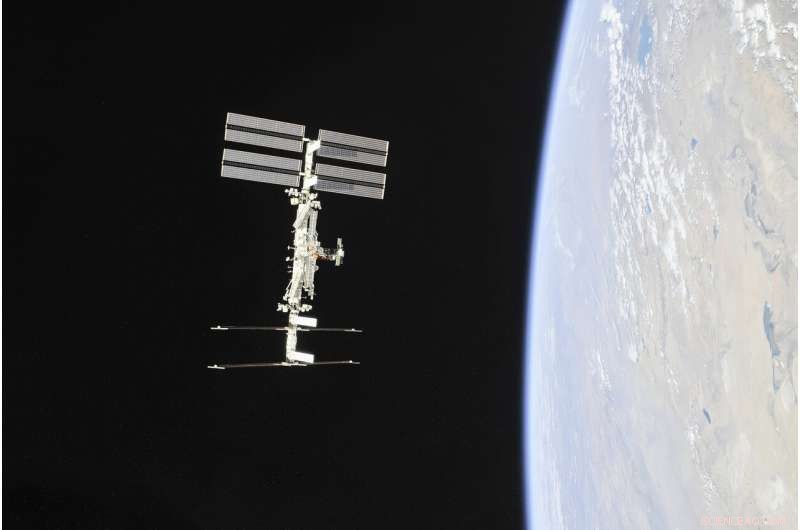
In this photo provided by NASA/Roscosmos, the International Space Station continues its orbit around the Earth as seen from a Soyuz spacecraft departing with NASA astronauts Andrew Feustel and Ricky Arnold and Roscosmos cosmonaut Oleg Artemyev, who had spent 197 days in space. From the first crew to the most recent, the No. 1 pastime aboard the station is gazing down at Earth. It takes just 90 minutes to circle the world, allowing crews to soak in a staggering 16 sunrises and 16 sunsets every day. (NASA/Roscosmos via AP)
When Shepherd and his crewmates returned to Earth aboard shuttle Discovery after nearly five months, his main objective had been accomplished.
"Our crew showed that we can work together, " han sagde.
© 2020 The Associated Press. Alle rettigheder forbeholdes. Dette materiale må ikke offentliggøres, udsende, omskrevet eller omfordelt uden tilladelse.
 Varme artikler
Varme artikler
-
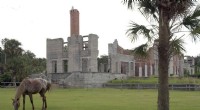 FAA forsinker igen den endelige beslutning om Georgias rumhavnstilladelseI denne 20. sept. 2008, fil foto, en vild hest græsser ved siden af ruinerne af Dungeness-palæet i den sydlige ende af Cumberland Island i Camden County, Georgia National Seashore. Et føderalt agent
FAA forsinker igen den endelige beslutning om Georgias rumhavnstilladelseI denne 20. sept. 2008, fil foto, en vild hest græsser ved siden af ruinerne af Dungeness-palæet i den sydlige ende af Cumberland Island i Camden County, Georgia National Seashore. Et føderalt agent -
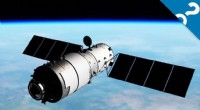 Kinas rumstation er på et styrtkurs med jordenHowStuffWorks nu:falder rumstationen i Kina? HowStuffWorks Da Kina lancerede Tiangong-1 (bogstaveligt talt, Heavenly Palace-1) rumstationsmodul i 2011, det var med den forståelse, at laboratoriet en
Kinas rumstation er på et styrtkurs med jordenHowStuffWorks nu:falder rumstationen i Kina? HowStuffWorks Da Kina lancerede Tiangong-1 (bogstaveligt talt, Heavenly Palace-1) rumstationsmodul i 2011, det var med den forståelse, at laboratoriet en -
 I kolliderende galakser, en pipsqueak skinner klartLysegrønne kilder til højenergi røntgenlys fanget af NASAs NuSTAR-mission er overlejret på et optisk lysbillede af Whirlpool-galaksen (i midten af billedet) og dens ledsagende galakse, M51b (den lys
I kolliderende galakser, en pipsqueak skinner klartLysegrønne kilder til højenergi røntgenlys fanget af NASAs NuSTAR-mission er overlejret på et optisk lysbillede af Whirlpool-galaksen (i midten af billedet) og dens ledsagende galakse, M51b (den lys -
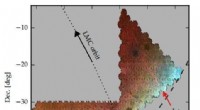 Ny stjernestrøm opdaget af astronomerFalsk-farvet kort over tætheden af stjerner med 0,1
Ny stjernestrøm opdaget af astronomerFalsk-farvet kort over tætheden af stjerner med 0,1- Kunstig intelligens teknikker rekonstruerer mysterier i kvantesystemer
- Brug af kunstig intelligens til at forbedre energi- og ressourceeffektiviteten i forskellige industr…
- Drivhusgasser var den vigtigste drivkraft bag klimaændringer i den dybe fortid
- Lucy-mission afslutter kritisk designgennemgang
- Dyrkning af alger mere bæredygtigt til produktion af biobrændstof
- Robotstyret videospil får ældre voksne ud af komfortzonen, lære og arbejde sammen


